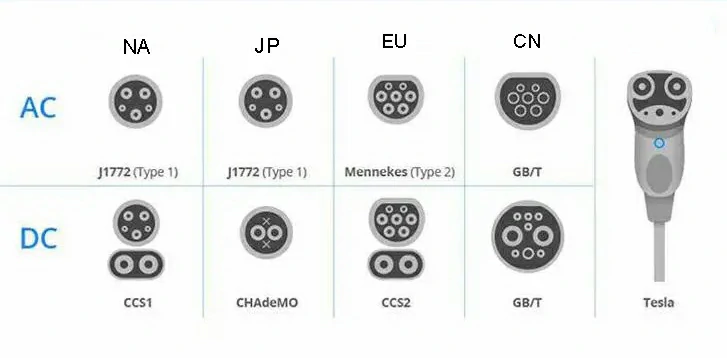
Vehicle-to-Grid (V2G): The Future of EV Charging and a Smarter Energy Grid
Vehicle-to-Grid technology is redefining the role of electric vehicles, turning them into dynamic energy assets that benefit drivers, utilities, and the planet.

Nowadays, the electric vehicle market is expanding rapidly and it is crucial for potential electric vehicle buyers to choose the right charging plugs. Before we determine how many types of plugs are on the market, let’s understand the EV charging process.
The EV charging process does not just go from the grid to the battery, but in between it needs to go through a charging post, a charging cable line, a charging plug, and an EV outlet port to get into the vehicle.
For AC charging, after it enters the vehicle, it does not go directly to the battery, it has to go through two gates in between, the on-board charger and the BMS. For DC charging, the AC power from the grid is rectified by the charging equipment and then fed directly into the electric vehicle.
At present, there are AC and DC charging guns. AC posts are mostly used for home charging and charging scenarios between commuting to and from work, while DC posts are mostly used for emergency charging and replenishment of power in medium and long-distance driving.
AC charging gun charging interface is mainly divided into three kinds, Type1, Type2, GB/T. Tesla has its own dedicated standard charging port, but depending on market conditions, Tesla is also equipped with a national standard charging port.
Type1 charging gun is mainly used in the United States and other countries like Japan, and it has two charging voltages, namely 120V (Level1) and 240V (Level2).

(Source: Joint.com)
Type2 is the interface standard for new energy vehicles in Europe, and the rated voltage is generally at 230V. The appearance is somewhat similar to GB/T interface, but it is not difficult to distinguish, the overall size of Type2 is larger than GB/T, and the circle connection hole part is hollowed out, which is the opposite of GB/T.

(Source: Joint.com)
General 220V household voltage is the rated voltage specified by the national standard AC charger. China’s regulations from January 1, 2016, as long as the domestic production of each brand of new energy vehicles charging interface must comply with the requirements of the national standard GB / T20234.
DC charging gun charging ports have their own standards in each region. There is no doubt that knowing each standard will be helpful in choosing an electric vehicle in the future.
CCS, Combined Charging System, originated from the American Society of Automotive Engineers SAE standard and the European Automobile Industry Association ACEA standard based on the DC fast combined charging system combo standard. In 2012, the “Fast Charging Association” was officially established at the 26th World Electric Vehicle Conference in Los Angeles, USA.
In the same year, eight major US and German car companies, namely Ford, General Motors, Volkswagen, Audi, BMW, Daimler, Porsche and Chrysler, issued a statement on the establishment of a unified fast charging standard for electric vehicles and announced the joint promotion of the CCS standard. The standard has been endorsed by the U.S. and German automotive industry associations.
This charging interface integrates normal charging and fast charging into one plug and socket, using single-phase, three-phase AC and DC power, and has become the common charging post standard in the US and EU countries, as well as in countries that have adopted the US and EU standards, such as South Korea, Singapore, India and Russia.
Japan has strong industrial strength and automotive technology, early development of electric vehicles, and a great advantage in the promotion of charging post standards.
In the face of competition from Japanese charging post standards, the EU adopted the Alternative Energy Infrastructure Construction Directive in September 2014, proposing to ban the construction of Japanese CHAdeMO standard charging posts in public charging stations from 2019.
The CCS2 became the main European Charging post standard, at present, European brands such as Audi, BMW and Mercedes-Benz support CCS2 standard charging post.
CHAdeMO, translated as “short charging time like tea break”, is a standard launched by Japan Electric Vehicle Association and Japan Electric Vehicle Charging Association. Japan’s largest car manufacturers such as Toyota, Nissan, Mitsubishi and Tokyo Electric Power Company support this standard, which has been extended to many countries.
The rated voltage of DC charging posts is generally above 400V and the current reaches several hundred amps, which are generally used in shopping malls and gas stations.

(Source: the Internet)
Each charging plug interface has its own unique appearance and follows the standard, and from the whole international perspective, there is no unified use standard. However, no matter which charging interface is used, all of them have their pros and cons and are important channels for communication and information exchange between charging posts and batteries of electric vehicles.

Vehicle-to-Grid technology is redefining the role of electric vehicles, turning them into dynamic energy assets that benefit drivers, utilities, and the planet.

At this ACT Expo, Joint Tech will unveil its latest advanced commercial Level 2 charging solution, designed to enhance the user experience. Meanwhile,powered by new technology, our commercial chargers effectively address multiple challenges encountered in real-world applications.

The new tariffs imposed by the United States have once again caused global economic tension.In order to respond to the impact on the global supply chain, Joint new factory in Malaysia offers favorable tax rates.
One Response